Gifts from God to Help Humanity Clean up Its Mess — episode 3
Tidal Stream, Wave Energy + Creative Imagination
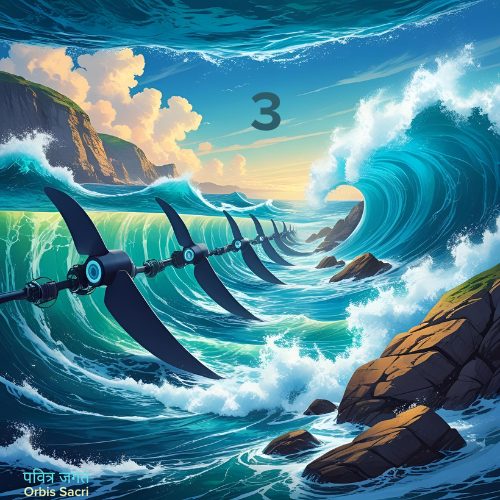
The potential for tidal stream and wave energy is staggeringly huge, yet the UK Government forgot to mention it in their Clean Energy Industries Sector Plan
In Episode 2, I brushed over the incongruity of a UK Government, almost religious zeal to deliver Net Zero by 2030, while entirely ignoring tidal stream and wave energy in its June 2025 ‘Clean Energy Industries Sector Plan’.¹
Electricity and heat are the most significant contributors of greenhouse gases across all sectors — see Figure 1
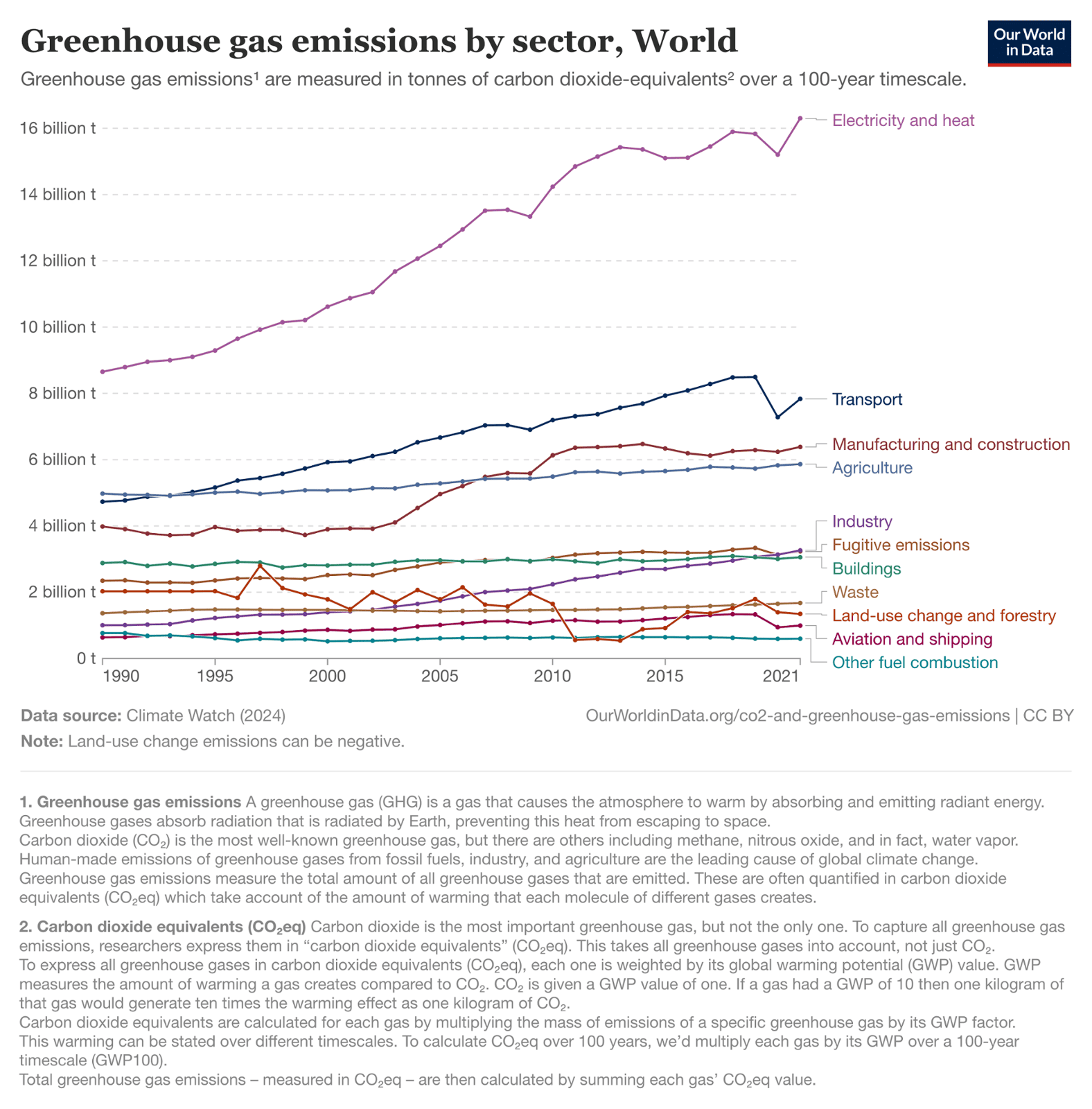
Finding clean energy alternatives is, therefore, critical for human long-term survival and the health of all life. While some may disagree with the aggressive timescale, especially given the current high energy costs, my beef with Ed Miliband, Secretary of State for Energy Security and Net Zero, and his team is their apparent lack of imagination regarding the clean energy portfolio their sector plan proposes.
I think it is worth exploring this negligently missed opportunity a little deeper before introducing the fifth and sixth pioneering heroes:
the Scottish tidal stream innovator, aptly named Nova Innovation, and
the French company, Seaturns.
The weather matters
According to the Government’s own figures, electricity generation from renewables fell by 4.9% to 46.3% in the first quarter of this year due to record-low wind speed and a 13% drop in wind power generation.² When the wind doesn’t blow and the sun fails to shine, gas is the default energy grid filler. Conversely, when it’s too windy, the grid gets congested, and we have the ridiculous scenario of paying wind farm owners (around £1 billion in 2024) to stop their wind turbines. That last issue is being addressed (hopefully) by reducing planning cycles and getting rid of ’zombie projects’, and increasing the grid’s capacity through £40 billion a year, mainly private investment, according to Ofgem CEO, Jonathan Brearley.³ Nevertheless, in stormy conditions where winds exceed around 55MPH, wind turbines are automatically stopped to avoid damage. This means that in both cases of no wind or high winds, wind turbines cannot contribute to the national grid. Tidal, on the other hand, is always on, except for the minutes of transitioning between outgoing and incoming tides.
From a technology perspective, tidal and, even more so, wave energy are at an earlier stage of maturity. Yet both will likely catch up within five to ten years.
Bizarrely, the Department for Energy Security and Net Zero, in its earlier guise as the Department of Energy and Climate Change, claimed in January 2013 that Britain could be helped by having around 50% of Europe’s tidal energy resource. Together with wave energy, it could meet up to 20% of the UK’s electricity demand, or 30–50 GWh/year.⁴ Can Miliband’s department not see this potential, or is it prejudiced against findings of non-Labour governments? As mentioned in the second episode, the University of Edinburgh’s report, these two under-exploited clean energy sources could potentially be worth around £100 billion net between 2030 and 2050.⁵
Ed Miliband, or more appropriately, Ed (Wind) Milliband, given his myopic fixation on onshore windmills and Quixote-like tilt to those offshore, shows precious little interest in what could be massive contributors to clean energy, and creating 15,000+ UK-based well-paid jobs by the end of this decade. What a staggeringly negligent omission!
My only hope is that the Marine Energy Taskforce (MET) launched on June 18, 2025, may come to the rescue, and the scales will fall from Wind Milliband’s eyes.
Mainstream media and opposition parties have missed the point
Sadly, there is no pressure on the government to do anything about it. The broadsheets, tabloids, and opposition parties are equally oblivious of the massive potential of tidal and wave energy.
The mainstream media shows more interest in the Net Zero battleground, leaving the public largely ignorant of the potential of tidal stream and wave energies. The fantasy science espoused by President Trump, that whales are being routinely killed by windmills, caught the interest of the BBC’s fact-checking team. It turned to Rob Deaville, project manager of the Cetacean Strandings Investigation Programme⁶ (CSIP), managed by the Institute of Zoology (ZSL). The programme has been investigating the causes of beached whales and other cetaceans, dolphins and porpoises to uncover the real causes. Since the investigation began in 1990, 17,850 cetaceans have washed up on the UK’s extensive shores. In the late 1990s, chemical pollutants were found in the blubber of stranded harbour porpoises, leading to an EU ban of brominated flame retardants in 2004. Other causes include fatal interactions with fishing gear and even sonar interference from naval exercises, leading to a ban by the Spanish Government for such activities around some of the islands where cetaceans are prevalent. After 4,300 forensic postmortems, there was no evidence of wind farm impact.
I prefer to heed the factual evidence of scientists over presidential bias and fossil fuel-financed hoodwinking. What disappoints me is the lack of reporting or assessment of Milliband’s sector plan. Trump captures attention through his outlandish protestations. But there is a far more important story to uncover within the sector plan. The implications are profound, and poor choices made now threaten to derail what could become our clean energy industrial revolution, with the UK at the forefront. Sadly, the media has failed to see this and missed the point — negligence of reporting, compounding negligence in policy making.
We need an Ocean Energy-based Moonshot
In her widely respected book, Mission Economy: A Moonshot Guide to Changing Capitalism, Professor of the Economics of Innovation, Mariana Mazzucato, explored the reasons behind the US’s success in reaching the moon, kicked off by President John F. Kennedy’s bold mission. She observed that ‘The problem is not ‘big government’ or ‘small government’. The problem is the type of government: what it does and how.’⁷ She also stated that ‘governments can play a vital role in coordinating industrial efforts and setting standards that create markets. But they must make the decision to pick a strategy, and tilt the playing field in that direction.’⁸
She identified six attributes behind the success of the Apollo programme:
Vision infused with a strong sense of purpose
Risk-taking and innovation
Organisational dynamism
Collaboration and spillovers across multiple sectors,
Long-term horizons and budgeting focused on outcomes
Dynamic partnerships between the public and private sectors.
Some signs of light on the horizon
Although I’ve painted a gloomy assessment of Miliband & Co., there are some positive signs that parts of the ecosystem of innovators, public bodies and academia are collaborating and providing mutual support. The Menter Môn tidal stream energy project off the Anglesey coast in Wales is a case in point. It involves collaboration between the Welsh government, Natural Resources Wales, and the Crown Estate, which owns the seabed and tidal stream device developers, including two I have written about: Minesto (see episode 1), and Inyanga (episode 2), and others involved in the supply chain. Unlike the EV industry, where innovation happens behind closed doors, both the tidal stream and wave energy innovators involve multiple parties, including organisations such as EMEC , providing testing facilities. It’s a highly collaborative and transparent affair. All six attributes exist; however, while the government talks a lot about missions, it appears that it hasn’t quite grasped the concept of interdepartmental collaboration. I hope I am proved wrong, and the emerging tidal and wave energy industry isn’t being fobbed off with quangos like MET. To end this section on a bright note, on July 31 2025, construction has started on the Cydnerth Holyhead infrastructure project to increase grid capacity for the Morlais tidal energy scheme from 18 MW to 240 MW, an order of magnitude further in the desired direction — and a £16 million investment backed by Welsh Government funding through the North Wales Growth Deal.
Perhaps the brightest note is the persistence, innovation, and courage of tidal stream and wave energy developers, collaborative innovation catalysts such as EMEC and Offshore Renewable Energy (ORE) Catapult, and their impact investors, as the stage of commercialisation rapidly approaches.
It’s not about competing with wind or solar, but strengthening our clean energy portfolio. The equation for clean energy resilience is outlined in Figure 2.
Although I’ve painted a gloomy assessment of Miliband & Co., there are some positive signs that parts of the ecosystem of innovators, public bodies and academia are collaborating and providing mutual support. The Menter Môn tidal stream energy project off the Anglesey coast in Wales is a case in point. It involves collaboration between the Welsh government, Natural Resources Wales, and the Crown Estate, which owns the seabed and tidal stream device developers, including two I have written about: Minesto (see episode 1), and Inyanga (episode 2), and others involved in the supply chain. Unlike the EV industry, where innovation happens behind closed doors, both the tidal stream and wave energy innovators involve multiple parties, including organisations such as EMEC , providing testing facilities. It’s a highly collaborative and transparent affair. All six attributes exist; however, while the government talks a lot about missions, it appears that it hasn’t quite grasped the concept of interdepartmental collaboration. I hope I am proved wrong, and the emerging tidal and wave energy industry isn’t being fobbed off with quangos like MET. To end this section on a bright note, on July 31 2025, construction has started on the Cydnerth Holyhead infrastructure project to increase grid capacity for the Morlais tidal energy scheme from 18 MW to 240 MW, an order of magnitude further in the desired direction — and a £16 million investment backed by Welsh Government funding through the North Wales Growth Deal.
Perhaps the brightest note is the persistence, innovation, and courage of tidal stream and wave energy developers, collaborative innovation catalysts such as EMEC and Offshore Renewable Energy (ORE) Catapult, and their impact investors, as the stage of commercialisation rapidly approaches.
It’s not about competing with wind or solar, but strengthening our clean energy portfolio. The equation for clean energy resilience is outlined in Figure 2.
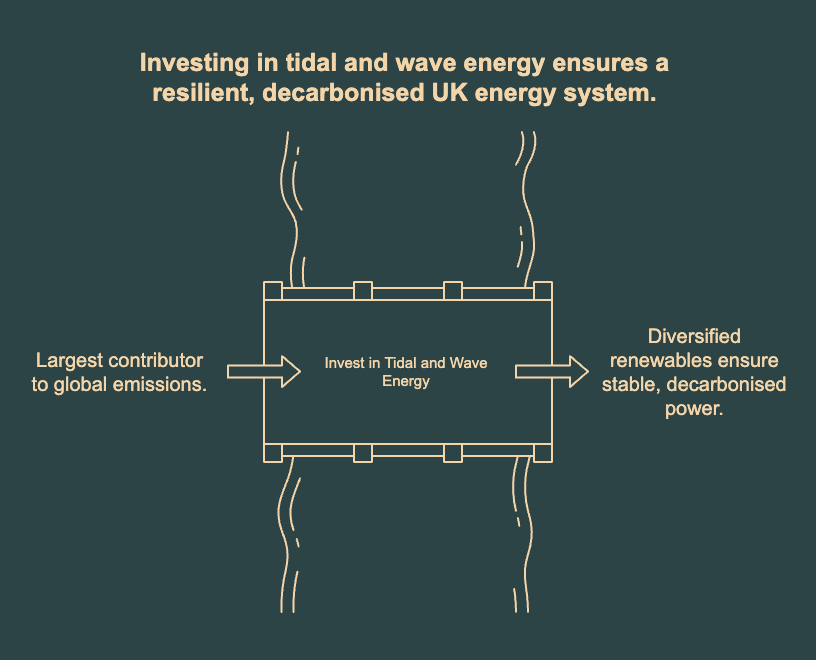
Y
Can’t Mr Miliband see this?
Now let’s turn to two more of these courageous innovators, Tidal stream pioneer, Nova Innovation and wave innovator, Seaturns.
Nova Innovation - Tidal Stream and Floating Solar pioneers
Nova Innovation was co-founded in May 2009 by Dr Simon Forrest, its CEO, and Dr Gary Connor, the CTO. Both have a deep background in energy and engineering and are currently supported by a team of equally experienced engineers.
Their mission is to be a leader in floating solar and tidal stream energy. Of the pioneering companies I have covered in this series of articles, Nova Innovation is the first one working in adjacent ocean energy fields. As this series is devoted to tidal and wave energy pioneers, my focus will be on Nova’s tidal stream technology and projects. Those interested in its can follow the embedded link.
Nova Innovation is one of the first tidal stream innovators
Figure 3 provides an overview of the organisation’s timeline.
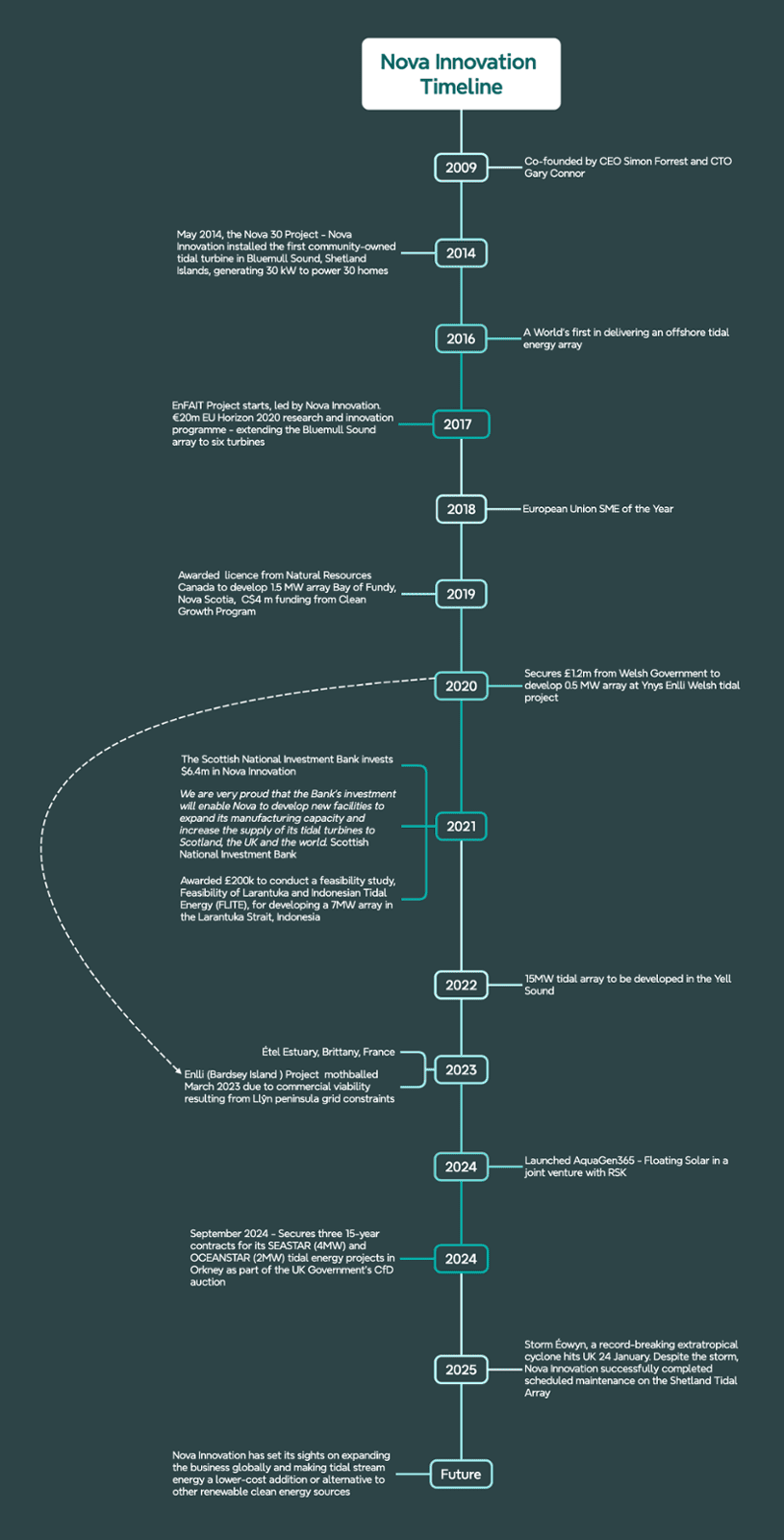
In keeping with its mission to lead, Nova installed the world’s first offshore tidal array connected to the national grid in the Bluemull Sound in 2016. Two years earlier, it had installed the first community-owned tidal turbine generating 30kW to power thirty homes — the Nova 30 project. This proved the efficacy of its design and its simplicity, described by John Meagher, director of business development, as a water ‘wind turbine’ where water, being 800 times denser than air, allows it to capture significantly greater energy. I’ll explore their pioneering projects later in this article, but first, an overview of their products and services capabilities that lead to real-world pioneering tidal stream solutions and commercialisation.
Nova Innovation takes a holistic approach to tidal stream opportunities and learns by doing
Nova Innovation takes a solutions delivery approach, combining innovative products with services.
Minimise complexity through creative simplicity
Practicality through simplification of product design is a core attribute of Nova’s approach to tidal opportunities. The TiPA (Tidal Turbine Power Take Off Accelerator) project lowered costs by 29% with the development of its second-generation D2T2 direct-drive turbine. It has no gears, eliminating the risk of costly gearbox failures, making it more resilient, reliable and significantly reducing cost. The M100D model depicted in Figure 4 is its latest version, suitable for aquaculture and other localised community requirements. The more powerful M500D is for large-scale utility deployments. All the Nova tidal energy turbines sit on the seafloor, out of sight and below the hulls of any passing boat.
The advantage of tidal energy over wind and solar is its predictability, days, months and years ahead. Tidal energy ebbs and flows predictably with the movement of the tides. By combining storage with its tidal energy converters, power can be provided smoothly to meet the baseload demand.
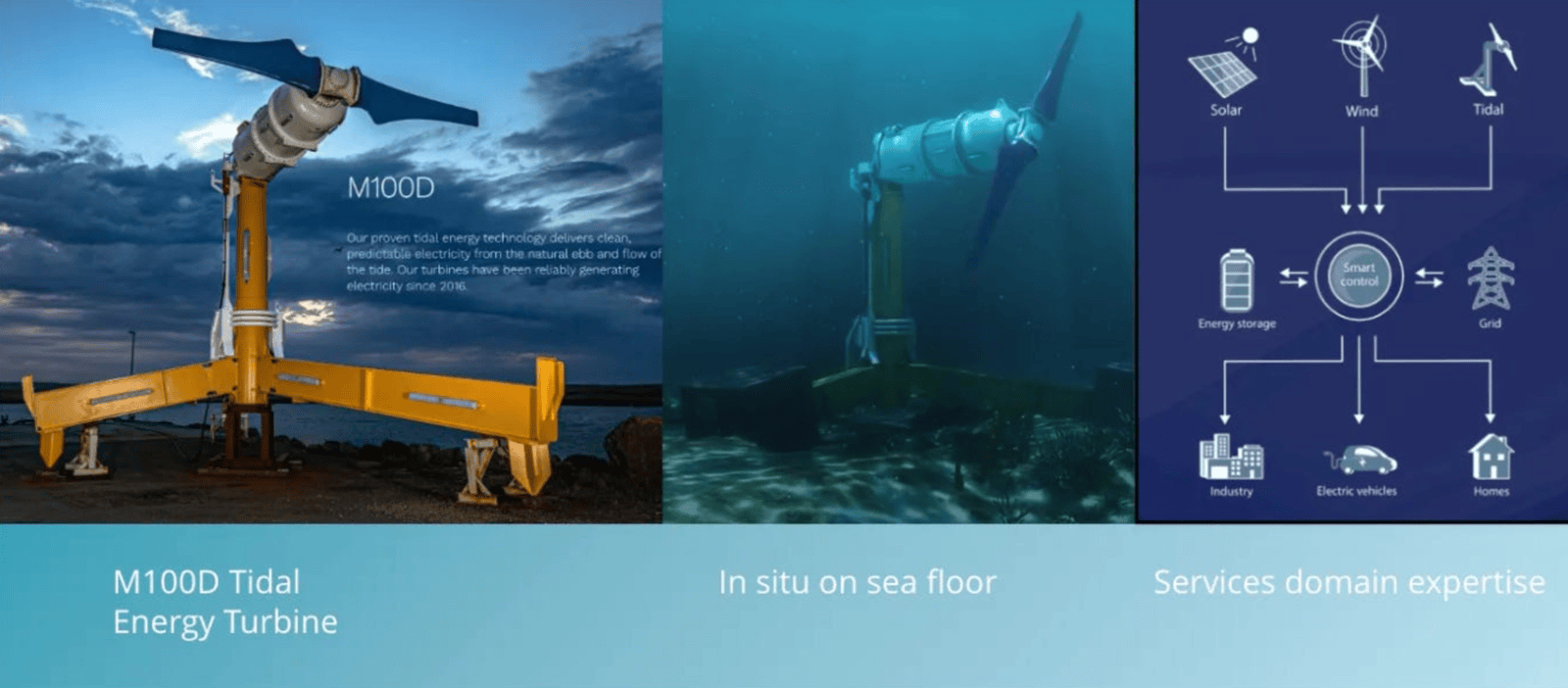
Nova’s holistic approach applies to the entire delivery and maintenance processes. Its leadership in the Enabling Future Arrays in Tidal (EnFAIT) project in the Shetlands, funded by the EU’s Horizon 2020 programme, led to a 50% reduction in operational costs. Three turbines were brought in for maintenance, and the turnaround time was under a week.⁹
The consortium led by Nova also created a complete European supply chain with over half of the businesses involved in Scotland. Yet another example of why the government must include tidal from a Net Zero and GDP perspective.
Holistic services form part of the solution
Given Nova Innovation’s pioneering leadership in tidal stream energy, their experience allows them to provide very early-stage services to support future clients. This includes evaluating site suitability, building the case to secure seabed leases and licences, and obtaining consent from government organisations for energy projects. This extensive skill set will help them speed up the commercialisation phase of their development worldwide for both pure tidal and hybrid projects.
A word of caution
The projects outlined below and their timelines are based on secondary research. The dates and the progression from one project to another are my best interpretation from various secondary sources, including Nova’s newsletters and website. I attempted to contact the company several times to fact-check, but received no response. I believe what follows is reasonably accurate.
Nova Innovation proves its leadership credentials in pioneering projects in Scotland, Wales, France and Canada
Shetland Tidal Array and EnFAIT from 2016 to present
It is strange to imagine an innovator like Nova Innovation being exhibited in a museum. But in March 2024, one of its Nova 30kW turbine blades became an exhibit at the National Museum of Scotland, part of Scotland’s proud engineering history. In a sense, it illustrates the start of the company’s engineering ingenuity.
This led to the Shetland Tidal Array in the Bluemull Sound, attracting investment of £1.85m and a collaborative partnership from Belgium green energy company Elsa (parent company IDETA ), a £3.75M investment package supported by Scottish Enterprise, and further investment from the Scottish National Investment Bank of £6.4m in 2020. In 2018, licences were granted to expand the array to six turbines. The same year, Tesla energy storage was added.
As well as achieving a world’s first tidal array in 2016, in 2019, grid electricity supply exceeded 17,000 generating hours, proving its value. The fifth and sixth turbines, named Grace and Hali Hope respectively, were connected by a subsea hub, providing a single export cable to the grid, reducing the need for individual and more costly export cables.
Morphing into EnFAIT from 2017 to 2023
In 2017, the Shetland Tidal Array became part of the EnFAIT ( Enabling Future Arrays in Tidal) project funded by the €20.2m EU’s 2020 Horizon research and innovation programme. Its purpose was to prove the commercial viability of tidal power. Nova Innovation led a consortium of nine companies, including Belgium energy company, ELSA and academic research organisations. It was during the EnFAIT period that the tidal array reached six turbines. Another interesting aspect was the use of AI to optimise the tidal array.
Nova awarded a licence from Natural Resources Canada to develop a 1.5MW array in the Petite Passage, Bay of Fundy, Nova Scotia
In 2019, Nova was awarded a licence by Natural Resources Canada to develop a 1.5MW array underwritten by C$4 million from Canada’s Clean Growth Program. The 100 kW M100 turbines were manufactured in Canada, with the first one commissioned in 2021. The Bay of Funny has the world’s highest tides, which can reach 53ft in the Minas Basin. Canada also claims the second highest in Ungava Bay, Quebec, at a mean height of 32ft, with the Bristol Channel in the UK coming a close third at 31ft 6inches. The energy prize is massive, but more than one hopeful company has failed. The biggest hurdles faced are not just technological, although Cape Sharp tidal connected in 2016, but its blades were destroyed after 20 days. The other formidable hurdle is the restrictive regulatory barriers, especially from the environment and the fishing industry.
Nova Innovation Canada Ltd was awarded a five-year marine renewable energy permit to install up to 15 100kW turbines on the bottom of the Petit Passage on Digby Neck. It is hoped that their smaller turbines, which are easier to replace, will fare better in the less fierce tides and provide a platform for evolving sufficiently to cope with the mega-tides in the Minas Basin.
Meanwhile, the Ynys Enlli (Bardsey Island) in North Wales hits a roadblock
In 2020, Nova Innovation was commissioned to develop a five-turbine tidal array in three phases to deliver 500kW to come on stream in the 2023/4 timeframe. However, with regret, Forrest mothballed the project due to the lack of grid infrastructure on the Llŷn peninsula, making the project economically unviable. The term ‘mothballed’ was used by a Nova spokesperson, suggesting that once grid constraints are removed, the project may be resurrected at a later date.
In 2021, Nova was awarded £200,000 to conduct a feasibility study in Indonesia
Innovate UK awarded Nova Innovation £200,000 to conduct a feasibility study (Feasibility of Larantuka and Indonesian Tidal Energy (FLITE)) for a 7MW tidal array. Indonesia has around 17,500 islands, which currently rely on fossil fuels to provide energy for 270 million people. It has strong tides and the potential for abundant tidal energy. The study is in partnership with Institut Teknologi Sepuluh November (ITS) to conduct research and support a business case.
The FLITE project represents an essential step in expanding tidal energy technology to Southeast Asian markets, particularly given Indonesia’s significant tidal energy resources and the country’s commitment to increasing renewable energy production by 2030.
The project’s focus on the Larantuka Strait is strategically important, as this location has been identified as having one of the strongest tidal currents in Indonesia. The project’s focus was to make policy recommendations for the Indonesian government.¹⁰ Presumably, the feasibility study contributed to Indonesia’s state-owned power company, PLN, signing a deal in October 2024 with Inyanga Marine Energy Group (see the second episode article) to develop a 10MW tidal array. We can expect Nova to follow suit in those tidal areas where its technology has an advantage.
2023 Success in Brittany, France, on the river Étel Estuary with a 50kW turbine
Nova tested a 50kW turbine in the Étel Estuary between March and April 2023, as part of the ELEMENT project funded by Horizon 2020. The RE50 turbine was deployed facing into the ebb current, which flowed faster than the estuary’s flood currents to maximise power generation.
The Sustainable European Advanced Subsea Tidal Array (Seastar) will run from December 2023 to February 2029 — becoming the world’s largest tidal farm
Seastar and Oceanstar, both in the Fall of Warness site managed by EMEC, Orkney Islands, will significantly expand tidal energy in the UK.
The Nova consortium was awarded €20m in funding from the EU to install the 16-turbine 4MW array. The project was unveiled at COP28. This project builds on the successful Shetland Tidal Array and EnFAIT projects.
The OCEANSTAR Project, Environmental Monitoring & Mitigation Plan¹¹ will eventually have a total installed capacity of 10 MW and involve the deployment of up to nineteen of Nova’s next generation ‘Oceanstar’ M-series direct-drive turbines. In collaboration with EMEC, new infrastructure, including an offshore electrical hub, intra-array cabling, and a remote observation platform for environmental monitoring, will also be installed as part of the OCEANSTAR Project.
The first turbine will be installed in phase 1 by the end of 2025. Phase 2 will begin in 2027 with the installation of up to 19 devices, and will operate for 25 years, with decommissioning in 2052.
Leadership through enduring belief and persistence
Nova Innovation has broken through the commercialisation barrier after sixteen years of experimentation, based on a design philosophy of simplification. It is now well on its way to commercialisation and growth. Its journey has been sustained by a dogged belief in the potential of stream energy and persistence, with very little in the way of public exposure by the mainstream media. It is not alone in its pursuit, but it is undoubtedly among the leaders in stream energy. I look forward to hearing more, and especially its progress in the Bay of Fundy, an exhilarating prospect.
And now, from stream to wave energy, with French pioneer, Seaturns.
Seaturns, where childhood fascination with the sea evolves into the emergence of a French wave energy pioneer
Seaturns, based in Bordeaux, Nouvelle-Aquitaine, was founded by Frenchman Vincent Tournerie in November 2015, producing its first wave energy converter two years later. Since August 1989, he has been a managing partner at the specialist concrete construction company, Teasual, also in Bordeaux. Wave energy and concrete are worlds apart; however, Tournerie’s childhood passion for the sea inspired him to figure out how to convert wave power into clean electrical energy. He is backed by three highly seasoned engineers familiar with the energy sector:
Lawrence Sigaud, General Manager, mechanical engineer and offshore project management expertise gained across the world in Africa, Asia, South America and the Guadeloupe islands;
Gabriel Canteins, Director and Head of R&D, a 25-year marine energy veteran and expert, with a Phd in fluid dynamics;
Arthur Chauliac, Project Manager, and another energy sector veteran with 14 years at Exxon Mobil, with extensive experience in risk management and reliability.
Seaturns’ product design principles overcome some of the inherent challenges of wave energy conversion
Wave energy is marginally behind tidal stream in terms of commercialisation and maturity, but it is catching up fast. According to the World Economic Forum, wave energy has the potential to meet the entire world’s electricity needs.¹² However, developments are far behind other renewable energy technologies like solar and wind, and are only now becoming commercially viable.
It has taken over 200 years to create WECs that work and can stand up to the potentially hostile and battering conditions generated by powerful waves, especially those with the highest energy conversion potential.
Interesting history of wave energy converters.
In 1799, a Frenchman, Pierre-Simon Girard, filed the first patent for a wave energy device. Its purpose was to power irrigation pumps, so it was more of an onshore solution, which sadly remained a concept.
In 1910, another Frenchman, well ahead of his time, Bochaux Praceique, constructed the world’s first oscillating water column, a WEC of sorts, that successfully powered the lights in a house in, coincidentally, Bordeaux. The idea did not catch on.
Serious attempts to develop WECs since the 1990s and early 2000s have generally failed, primarily due to harsh marine conditions and technological complexity, where any one of many moving parts that fail can scupper the entire project. Survivability during extreme wave loads and the fluctuating nature of waves require components that must be designed to handle loads many times greater than the average load, which incurs higher costs. A greater power take-off (PTO) capacity than the average power output will be more expensive, impacting commercial viability.¹³
Other potential issues include concerns about the environmental impact on ecosystems. Most of the concerns have been about possible damage to fish through collisions with underwater turbine blades or noise disturbing marine life. Generally, various studies show that most of these fears are unwarranted, although large wave energy farms are only just emerging. In any event, Seaturns ‘floaters’ and future WEC-farms do not use turbine blades, and their design is minimalist.
Simplicity and adaptability are critical design principles
Pioneering companies like Seaturns are typically led by visionary leaders who convert challenges into well-designed solutions and work with engineers who share their enthusiasm and beliefs. Tournerie has done that and focused on simplicity, adaptability to sea conditions and resilience as foundational principles in their evolving WECs. Having benchmarked existing WECs, Tournerie settled on a cylindrical geometrical shape as it is one of nature’s most robust designs and therefore should withstand marine stresses, however extreme.
Figure 5 illustrates the innovative Seaturns Floater, which floats on the surface of the water.
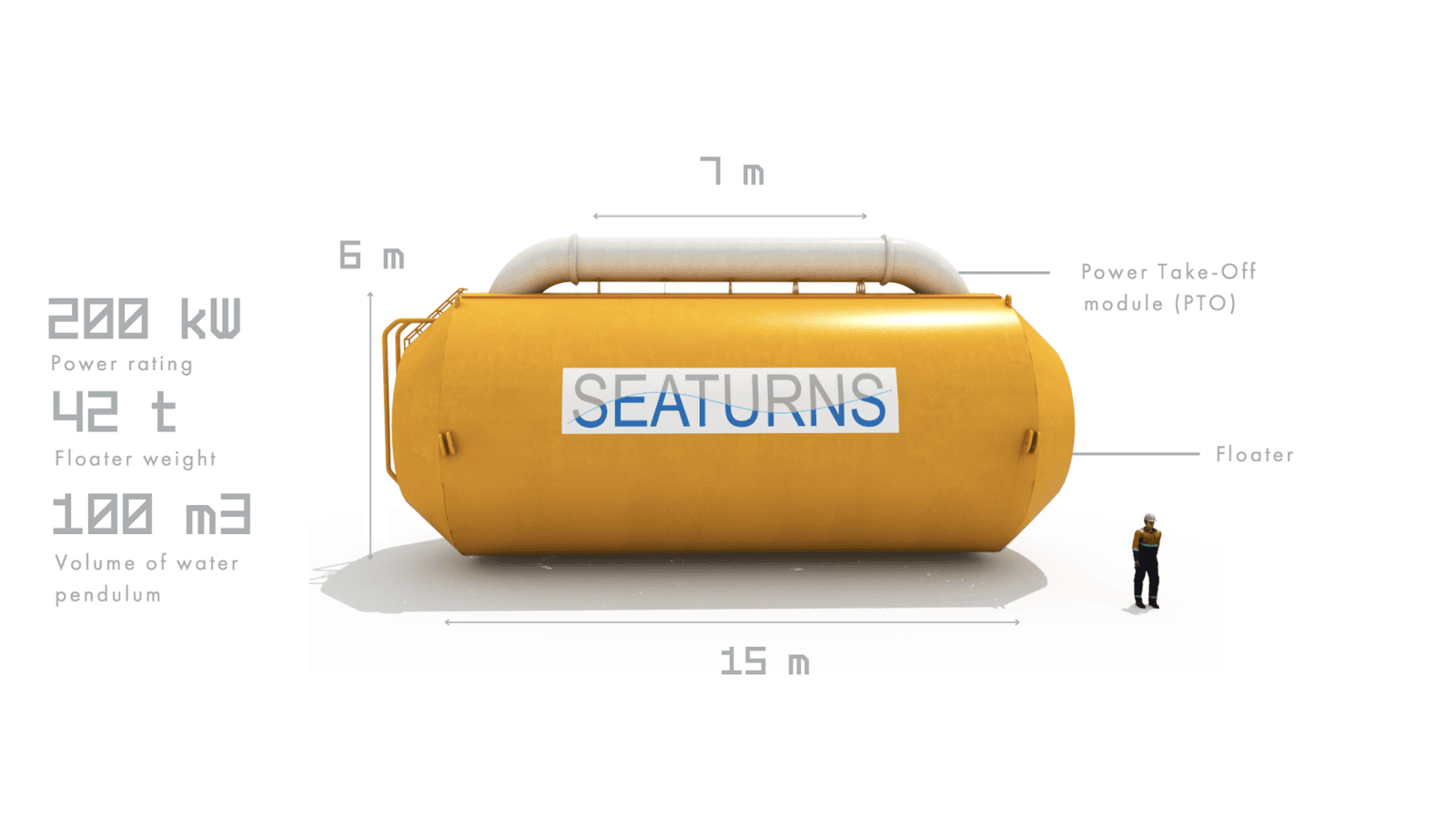
Concept details: Under wave action, the cylindrical floater moves horizontally, creating a back-and-forth motion called surging. This motion is converted into pitching (rotation around the floater’s axis) through an innovative anchoring system. Inside the floater, a water pendulum and two air-filled chambers generate pressure cycles, producing airflow that spins a turbine coupled to a generator to produce electricity.
Maintenance and operations: The Power Take-Off (PTO) module in the white section is fully detachable and replaceable directly at sea, greatly simplifying maintenance and reducing operational costs. The Power Take-Off module on top houses the air flux control system, a turbine and an electrical generator with an embedded control mechanism.
Shared anchoring system: Up to 10 floaters can be anchored along a single line, optimising costs and minimising the impact on the seabed. Seaturns floaters are moored using a patented anchoring system that allows multiple units to be anchored along a single mooring line. This design reduces installation costs and minimises ecological impact on the seabed. Figure 6 is an illustration of how a Seaturns wave farm will look.
Durable casing:
The floater is made of welded steel sheets, providing durability in extreme marine conditions. It is an ingenious design involving minimal moving parts. This overcomes the issues faced by earlier complex WEC designs, and allied to its robust shape, makes it a promising candidate for commercialisation.
Low carbon emissions:
Remarkably, carbon emissions are extremely low at 15g CO₂/kWh, which compares very favourably with solar at 40 and a minuscule fraction compared with all fossil fuels. The floaters are also recyclable up to 98%.
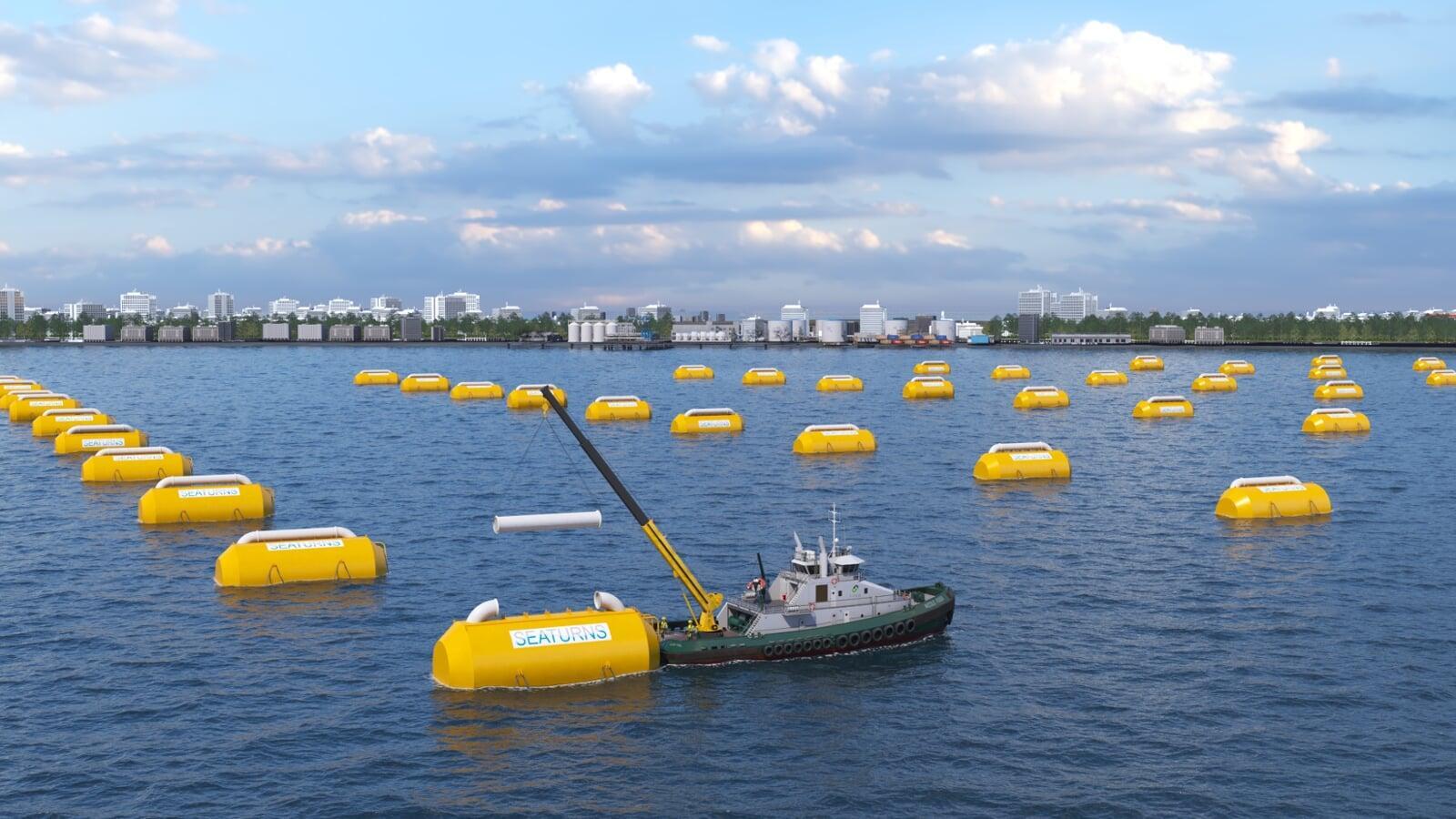
From pilot to the cusp of commercialisation — Seaturns’ impressive progress
The timeline in Figure 7 depicts Seaturns’ journey from original concept through to sea trials starting in 2025 and imminent commercialisation expected the following year.
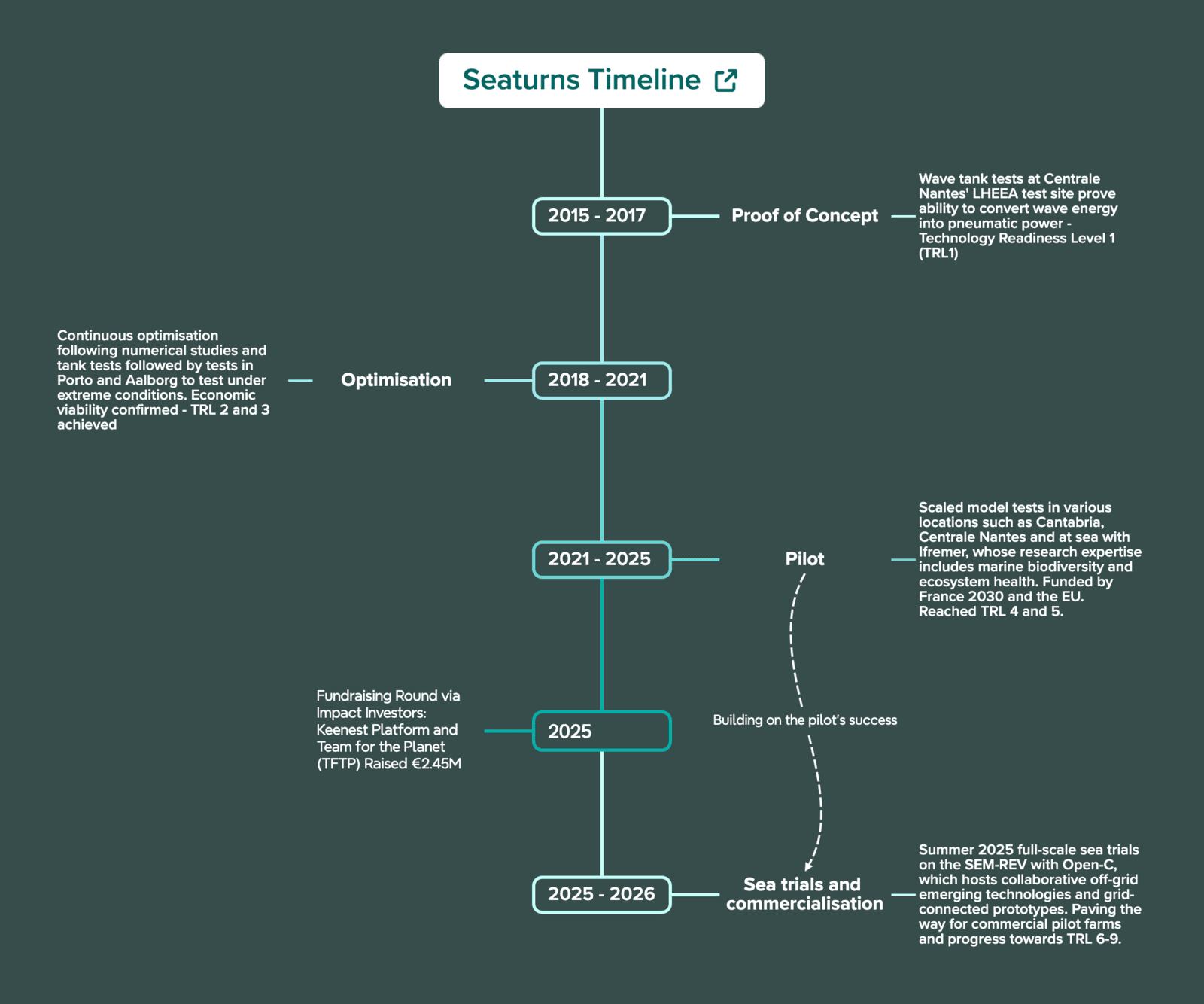
The first step, Technology Readiness Level 1 (TRL1), was proving the concept at the LHEEA SEM-REV offshore test site on the Atlantic coast near Nantes. This confirmed the floater could convert wave energy into pneumatic power and then into electricity.
To optimise the floater, a series of numerical studies took place between 2018 and 2021, and physical tests in Porto, Portugal and Aalborg in the shallow sea off the Jutland peninsula, Denmark. As a result, economic viability was established across TRL2 and TRL3 levels.
Over the next three years, further pilots at 1:4 scale prototypes were tested at the French marine research institute, Ifremer’s test site at Sainte-Anne du Portico at the Brest harbour entrance. This consisted of two test phases. The first was to observe and record the floater dynamics, using a simplified system. The second phase included a working air turbine connected via a subsea cable to the shore to produce electricity.
Multiple sensors monitored the floater in a variety of wave, tidal currents and wind conditions. Anchor line testing and power outputs were also observed. Data from these sensors would be harvested and analysed to optimise a subsequent full-scale floater. Encouragingly, the entire floater system worked well even during storm Ciarán, which caused considerable damage across northwestern Europe from October to early November in 2023.
Throughout the pilot period, Ifremer research scientists monitored the environmental impact and found no damage or causes of concern for marine life. The pilot, funded by France 2030 and the EU, passed TRL4 and 5.
During this testing period at Ifremer’s test site, other tests were completed, including tank tests in Nantes and, vitally, wave farm testing, using a 1:15 scale floater array at the wave and ocean engineering basin of the Laboratories de recherché en Hydrodynamique, Énergétique et Environnement Atmosphérique (LHEEA) at the École Centrale de Nantes. These tests provided data that would significantly enhance sea trials of full-scale floaters and floater farms.
In the spring of 2025, a successful fundraising round provided investment from two impact investors, Keenest Platform and Team for the Planet. Vital resources for the next stop on the journey to commercialisation, starting in the summer of 2025 — the full-scale sea trials at SEM-REV, a founding member of the OPEN-C Foundation, Europe’s largest offshore energy testing centre. The full-scale trials will be carried out at SEM-REV’s facility in the Pays de la Loire region, imminently, and are expected to be completed in 2026. The next step after that is commercialisation. Based on progress to date and the resilient quality of their floater technology, it would not be surprising if forward orders are forthcoming before the end of 2026. By the end of this final stage, Seaturns will have progressed through TRL 6–9 and be ready for orders. Particularly as there are many different scenarios where Seaturns’ technologies and know-how will prove attractive.
Seaturns is on the cusp of commercialisation with potential in diverse scenarios across the world
Seaturns has already identified commercial uses for its floater WEC technology. These include:
Sustainable Island Developing States (SIDS), recognised by the UN as a special case at the 1992 UN Conference on Environment and Development, in Rio, Brazil. These are considered remote economies prone to natural disasters and with limited energy resources.¹⁴ The list of 39 SIDS can be found here. Seaturns can support micro-grid energy systems for off-grid islands with a minimum capacity of 2MW. Similarly, off-grid beach resorts could also be supported in this way.
Support for Maxi-Grid systems with large-scale wave energy farms, as part of a nation’s renewable energy mix.
As part of a green hydrogen production system, replacing fossil fuels that generate ‘grey’ hydrogen.
As power source for ports and marinas.
Data Centres are currently supplied by fossil-fuel energy sources or as part of a renewable mix. Data centres consume around 1.5% of the world’s electricity production. According to the International Energy Agency (IEA),¹⁵ the US accounted for 45% of the world’s data centre electricity consumption, followed by China at 25% and Europe at 15%. With the rapid increase in resource-hungry AI, by 2030, Data centre electricity consumption is set to more than double to 945 TWh. So this is a massive opportunity for reliable and clean energy.
In December 2023, the Cluster Maritime Français (CMF), supported by Indosuez Wealth Management, launched the French Blue Tech Index to raise the profile of marine renewable energy startups. Seaturns was recognised under the energy category for its impact and innovation. This is a powerful endorsement of the company’s commercial potential.
Seaturns has many advantages in wave energy
As we have seen, the story of Seaturns is about converting a visionary dream into reality.
Contributing to the planet’s protection without harming biosystems,
Innovative design supported by core principles of simplicity and adaptability,
Gaining the support and help of major research organisations and test centres like Ifremer and SEM-REV,
Catching the eye and receiving investment from impact investors, willing them on to greater success,
and the team steering Seaturns has the imagination to identify commercial scenarios where it will be well-placed to compete.
I started this article exposing the apparent myopia of the UK Government, despite its renewable energy flag-waving. However, I am deeply reassured that tidal stream and wave energy pioneers will find external support from more forward-thinking organisations and impact investors, to give them the lift they need to succeed, for all our sakes. Nova Innovation and Seaturns are two exemplary companies, and I look forward to hearing about their growth in the years ahead.
